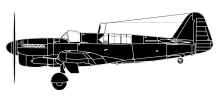
ASN Wikibase Occurrence # 241294
This information is added by users of ASN. Neither ASN nor the Flight Safety Foundation are responsible for the completeness or correctness of this information.
If you feel this information is incomplete or incorrect, you can submit corrected information.
| Date: | Tuesday 2 September 1958 |
| Time: | day |
| Type: |  Fairey Firefly U.9 |
| Owner/operator: | RNAS Yeovilton Ferry Flt FAA RN |
| Registration: | VT403 |
| MSN: | F.8303 |
| Fatalities: | Fatalities: 0 / Occupants: 2 |
| Aircraft damage: | Destroyed |
| Location: | RNAS Yeovilton/HMS Heron, Ilchester, Somerset -
 United Kingdom United Kingdom
|
| Phase: | Take off |
| Nature: | Military |
| Departure airport: | RNAS Yeovilton/HMS Heron, Ilchester, Somerset (EGDY) |
| HMS Falcon/RNAS Hal Far, Malta | |
| Confidence Rating: |
Fairey Firefly U.9 VT403: Delivered to Fairey Aircraft at Ringway Airport, Manchester 2/3/1956 for overhaul. Upon completion of this work, selected for conversion to Firefly U.9 pilotless target drone. Conversion began 26/8/1957, and first flown as such at Ringway 12/5/1958.
Delivered to RNAS Yeovilton (HMS Heron), Ilchester, Somerset 2/9/1958 and taken on charge by the Ferry Flight. This flight was a civilian operated unit, operated by Short Brothers & Harland Ltd., Rochester, Kent, using civilian pilots under contact. Firefly VT403 set off for HMS Falcon, RNAS Hal Far, Malta (probably for use by 728B Squadron FAA RN as an unmanned target aircraft for "Sea Slug" Surface to Air Missile Trials)
Written off (damaged beyond repair) 2/9/1958: Swung off the runway at HMS Heron, RNAS Yeovilton, Ilchester, Somerset due to the tailwheel being unlocked. The aircraft swung further off the runway at very low altitude just after becoming airborne. As a result, the takeoff was aborted, and severe rudder was applied to counteract the swing, avoid the Control Tower at Yeovilton, and avoid a row of parked De Havilland Sea Venoms. Firefly VT403 then struck the runway travelling sideways, causing the undercarriage to collapse, and the tip tanks to burst open. The leaking fuel from the tip tanks then caught alight, and the aircraft was burnt out in the subsequent fire.
The two crew members survived, albeit with slight burns injuries. Crew of Firefly VT403 were...
Mr. C.J.Kiss (Pilot - Civilian Contract Pilot Employed by Short Brothers & Harland Ltd)
REM (Radio Electrical Mechanician) H.D.Joyce RN (Passenger/Radio Systems Engineer)
Note that while Firefly U.9 was, by its very nature, capable of being flown unmanned, it was normally flown with at least one (and often two) crew on board for long distance delivery flights to Malta.
Formally Struck Off Charge as Cat.ZZ 3/9/1958
Sources:
1. Fleet Air Arm Fixed Wing Aircraft Since 1946 (Ray Sturtivant, Lee Howard & Mick Burrows, Air Britain, 2004 p.263)
2. Wings Over Somerset: Aircraft Crashes since the End of World War II By Peter Forrester
3. http://www.ukserials.com/results.php?serial=VT
4. http://www.ukserials.com/losses_drones.htm
Revision history:
| Date/time | Contributor | Updates |
|---|---|---|
| 12-Sep-2020 19:02 | Dr. John Smith | Added |
| 28-Dec-2020 15:41 | Anon. | Updated [Operator, Location, Departure airport, Destination airport, Operator] |
Corrections or additions? ... Edit this accident description
The Aviation Safety Network is an exclusive service provided by:


 ©2024 Flight Safety Foundation
©2024 Flight Safety Foundation